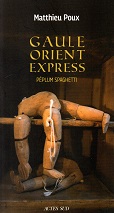
Celtic silver coins, circa 100 B.C
En SlovÃĐnie, immersion en compagnie dâAndrej Gaspari, archÃĐologue-plongeur, dans la riviÃĻre Ljubljanica oÃđ par milliers des reliques historiques allant de la pÃĐriode nÃĐolithique, celtique mais aussi romaine, et en passant par le moyen-ÃĒge, ont ÃĐtÃĐ retrouvÃĐes (dÃĐcorations militaires, haches, ÃĐpÃĐes, ÃĐpingles à cheveux, fibules, piÃĻces de monnaies, clefsâĶ).
PrÃĐsentation par le National Geographic magazine / dÃĐcembre 2006 :
nationalgeographic.com a ÃĐcrit:
By Carol Kaufmann ............................................... ...................... Photographs by Arne Hodalič
Why did Romans, Celts, and even prehistoric settlers submerge their personal belongings, from swords to dishes, in a shallow river in Slovenia?
Get a taste of what awaits you in print from this compelling excerpt.
http://www7.nationalgeographic.com/ngm/ ... index.html
Archaeologist Andrej Gaspari is haunted by pieces of the past. His hometown river, the Ljubljanica, has yielded thousands of themâCeltic coins, Roman luxuries, medieval swordsâall from a shallow 12-mile (19 kilometers) stretch. Those who lived near and traveled along the stream that winds through Slovenia's capital of Ljubljana considered it sacred, Gaspari believes. That would explain why generations of Celts, Romans, and earlier inhabitants offered treasuresâfar too many to be accidentalâto the river during rites of passage, in mourning, or as thanksgiving for battles won.
But Gaspari may never be able to explain for certain why the Ljubljanica holds one of Europe's richest stores of river treasures, many of them remarkably preserved by the soft sediments and gentle waters. Too many pieces of the puzzle have already disappeared.
During the past two decades, sport divers have made the river their playground, removing most of some 10,000 to 13,000 objects found so far. Even though removing artifacts from the Ljubljanica has long been illegal, professional archaeologists have been forced to compete with private collectors. Some divers sold their loot to museums; others to the highest bidder. Some kept their treasures private. Many artifacts have left the country, untraceable. Gaspari's greatest torment comes from the knowledge that few maverick collectors knowâor careâwhere exactly their prizes were found. For an archaeologist, an object's meaning comes as much from its contextâlocation, association with other objectsâas from the prize itself. Without context, there is no story.
Mladen MÞck is one of Gaspari's tormentors. Now in his 40s, the Bosnian-born architect began diving in the river in 1985 and has brought up about a thousand pieces. In his kitchen in Ljubljana, a plastic box contains prehistoric tools. Upstairs, dusty cases hold other rare artifacts, including deer antler axes. MÞck says he has no intention of selling what he has found. Like many collectors, he babies his goods and claims they are better off with him than with the authorities.
"More people see these artifacts in my house than if I gave them to a museum," he says with a dismissive wave. "There they would sit in a basement."
Gaspari disagrees. A team at the National Museum of Slovenia is preparing an exhibit of the river's treasures that will tour Europe in 2008, he says. Still, he hopes that someday MÞck will hand over his items. "My heart is strong," quips the 33-year-old archaeologist. If MÞck is obstinate, "I will outlive him."
Get the whole story in the pages of National Geographic magazine.
Le mythe celtique des "offrandes et du culte de lâeau" en prend un rude coup d'ÃĐpÃĐe !
Avez-vous plus d'infos sur les peuplades celtiques de la rÃĐgion ? De vraies histoires, des pourquoi, des comparaisons ..., et un petit moins des " on dit "... sur les offrandes et le culte de lâeau ?!
e.




